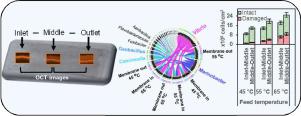Water Research ( IF 11.4 ) Pub Date : 2022-08-14 , DOI: 10.1016/j.watres.2022.118983 Harun Elcik 1 , Alla Alpatova 1 , Graciela Gonzalez-Gil 1 , Bastiaan Blankert 1 , Nadia Farhat 1 , Najat A Amin 1 , Johannes S Vrouwenvelder 2 , Noreddine Ghaffour 2

|
Biofouling is a hurdle of seawater desalination that increases water costs and energy consumption. In membrane distillation (MD), biofouling development is complicated due to the temperature effect that adversely affects microbial growth. Given the high relevance of MD to regions with abundant warm seawater, it is essential to explore the biofouling propensity of microbial communities with higher tolerance to elevated temperature conditions. This study presents a comprehensive analysis of the spatial and temporal biofilm distribution and associated membrane fouling during direct contact MD (DCMD) of the Red Sea water. We found that structure and composition of the biofilm layer played a significant role in the extent of permeate flux decline, and biofilms that built up at 45°C had lower bacterial concentration but higher extracellular polymeric substances (EPS) content as compared to biofilms that formed at 55 °C and 65°C. Pore wetting and bacterial passage to the permeate side were initially observed but slowed down as operating time increased. Intact cells in biofilms dominated over the damaged cells at any tested condition emphasizing the high adaptivity of the Red Sea microbial communities to elevated feed temperatures. A comparison of microbial abundance revealed a difference in bacterial distribution between the feed and biofilm samples. A shift in the biofilm microbial community and colonization of the membrane surface with thermophilic bacteria with the feed temperature increase was observed. The results of this study improve our understanding of biofouling propensity in MD that utilizes temperature-resilient feed waters.
中文翻译:

阐明炎热气候条件下海水膜蒸馏中热和空间梯度的生物污染
生物污垢是海水淡化的一个障碍,会增加水成本和能源消耗。在膜蒸馏 (MD) 中,由于对微生物生长产生不利影响的温度效应,生物污垢的发展是复杂的。鉴于 MD 与拥有丰富温暖海水的地区高度相关,有必要探索对高温条件具有更高耐受性的微生物群落的生物污染倾向。本研究全面分析了红海水直接接触 MD (DCMD) 过程中的时空生物膜分布和相关的膜污染。我们发现生物膜层的结构和组成对渗透通量下降的程度起着重要作用,与在 55°C 和 65°C 形成的生物膜相比,在 45°C 形成的生物膜的细菌浓度较低,但细胞外聚合物 (EPS) 含量较高。最初观察到孔润湿和细菌通过渗透侧,但随着操作时间的增加而减慢。在任何测试条件下,生物膜中的完整细胞都优于受损细胞,这强调了红海微生物群落对饲料温度升高的高度适应性。微生物丰度的比较揭示了饲料和生物膜样品之间细菌分布的差异。随着进料温度的升高,观察到生物膜微生物群落的变化和嗜热细菌在膜表面的定殖。











































 京公网安备 11010802027423号
京公网安备 11010802027423号